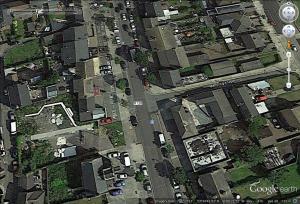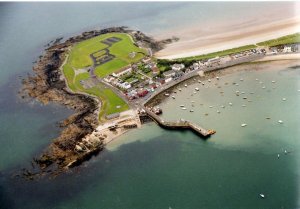2009
That unprepossessing green patch, Floraville, half way along Strand Street, was so ugly that a wall was built to hide it from view. Google earth can transport us back in time to—2005. My memory, however erratic, can do better than that. I recall Floraville when there was a house of that name standing there. In 1950, a mere five years after the War and only three years after the terrible winter of 1947, Ireland determined to go en fete, emerge from the darkness of the Forties and develop a tourist industry.Villages and towns throughout the island, began to organise festivals and events to lift the gloom. This didn’t happen by government decree. It happened because civic-minded people got together and worked for the benefit of their fellow citizens. A major Irish industry enjoyed an immediate revival…scoffing and ridicule. People of a certain age, remember The Bowl of Light on O Connell Bridge, immediately renamed The Tomb of the Unknown Gurrier. Somebody threw it into the Liffey. The gurrier is alive and well. Steinbeck once remarked, on seeing a man rescuing a statue from a canal/river, (Erratic memory) that there are two kinds of people, folks who throw things into rivers and folks who pull things back out again. Very occasionally you will see an old, cast-iron, An Tóstal road sign with the stylish, female harp, an early symbol of Ireland. Your best chance of seeing one nowadays is in an ‘Irish’ pub, somewhere abroad, possibly stolen by some gurrier.
We always say: “They should do something about that.” The Floraville Committee members were that ‘They.’ There was a flag pole, giving the house a semi-official standing. They organised events in the old house, lectures, classes in music and dancing, slide shows, exhibitions, club meetings and whist drives. On Saint Patrick’s Day, The Skerries Brass and Reed Band started from there. The Graduates, a popular showband, practised there on Sunday mornings, their music occasionally adding a lively beat to Mass in the church nearby. Cycle races and occasionally running and walking races started there. The motor bikes of the Skerries 100 thundered impatiently on the starting grid, eager to be away into the country. Military parades, on a modest scale, began or ended on the broad space between Floraville and the library. There was a man called Bob in the F.C.A. who had a very deep, gruff voice. When the parade marched up Strand Street and wheeled right to salute the flag, the crowd watched in respectful silence. The boots clattered on the pavement. The officer called a command. Just one other voice was audible. Bob’s : “Walk on your own feet—b****x.” It took away from the solemnity of the occasion but it became a catchphrase with us schoolboys.
There was street dancing for An Tóstal, late at night. I was too young for romance. Grown-ups waltzed under the street lights. They were ancient, some of them in their twenties and thirties. It was all very strange. One of our classmates, in truth, a little gurrier, circulated furtively through the throng, jabbing the dancers with a hat-pin. The music drowned out their cries of pain. He returned to report his success at intervals. Nobody could catch him because of his size. He came back in astonishment. The point of the pin was bent at right angles. Some spoilsport was wearing whale-bone body armour, better than kevlar. We gazed in wonder at his blunted weapon. He wouldn’t escape now. He is too slow and corpulent. Street dancing? It has always struck me as one of the great injustices suffered by Irish Catholics that on Mardi Gras, the South Americans celebrate with samba bands and women definitely not wearing whalebone, dancing in the streets, while we, the most faithful followers of the Church for thousands of years, dungeon fire and sword and all that, get pancakes—admittedly with sugar and lemon. I suppose February can be a chilly month. I digress.
2013
They have been busy again. Some civic-minded people with a bit of imagination,vision and generosity, have transformed the Floraville site into a welcoming garden, a South American style plaza (ahem!), an oasis in the centre of town. With stone, concrete, glass and lawn, they have created a place that literally embraces the visitor. The long seat mimics the shape of our much loved harbour. Believe me, you will be able to walk on the waves. The transverse line from East to West, like the aisle of a great cathedral, marks the boundary between the two historic parts of Skerries, the original Norse settlement at Hoar Rock and the townland of Holmpatrick. Centuries ago these two entities coalesced to form Skerries. They have invited us to commemorate those whom we cherished, a husband or wife, a child who slipped away too soon, grandparents, friends and colleagues, with their names engraved in granite on the path of memories. These were all, in their individual ways, building blocks of our community. It is simple, appropriate and beautiful.
Margaret and I have chosen to commemorate our parents, the grandparents of our children, the great-grandparents of our grandchildren. They were always great. Tom came to Skerries at the age of five, an orphan, boarding with the Holy Faith Sisters. He returned with a young family in 1939, fearing that Dublin would be bombed in the impending war. He had had enough of war. A shrewd judgment on two counts. His wife, Kay, taught and educated generations of Skerries girls in the Holy Faith Convent. She is still remembered by her pupils. Barney joined the Civic Guards at the inception of the force. He served in Skerries and Balbriggan and was the youngest sergeant, at the age of nineteen. In his personal integrity and inflexible respect for the rule of law, he embodied the finest traditions of the Garda Síochána, the Guardians of the Peace. It was no small thing to join an unarmed police force in the middle of a bitter civil war. Terrified as he was of the sea, he nevertheless pulled an oar on the lifeboat in an emergency. He found his life’s love in Rita, whose warm and gentle nature touched all who knew her. She made all mother-in-law jokes incomprehensible to me.
Their memory will always be here now, in Floraville Garden, safe within harbour
Where no storms come
Where the green swell is in the havens dumb
And out of the swing of the sea.




beautiful
LikeLike
Do you recall a poem by, I think, by John Hewitt? “Like dolmens round my childhood, the old people..” I think of them as building blocks. Thank you for your comment. Much appreciated as always. No doubt you have memories of Floraville going away back.
LikeLike
Hi, I remember in the 60’s Floraville was where those of us too young for “The Pav”, had our hops. Wonderful memories. Michael.
LikeLike
Wonderful, indeed, Michael.
LikeLike